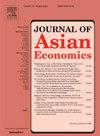A study on the long-term trend of middle-aged female labor supply in urban China: The explanation from inter-generational care
IF 3.4
3区 经济学
Q1 ECONOMICS
引用次数: 0
Abstract
This study is the first to examine the long-term impact and trend of intergenerational care on the labor supply of middle-aged women. The primary data are drawn from the 2002, 2013, and 2018 China Household Income Project surveys. The findings reveal that the effect of intergenerational care on the labor supply has strengthened over the past two decades. Although the effect was not significant in 2002, it became highly significant by 2018. Decomposition analysis shows that compared to the endowment effect, the coefficient effect of intergenerational care was a key driver of the decline in labor supply among middle-aged women between 2013 and 2018, accounting for 16.81 % of the total change. Further analysis indicates that the expansion of public preschool education in 2018 encouraged young mothers to return to the labor market, thereby increasing the time burden of caregiving for middle-aged women. Simultaneously, the rising cost of education added to the financial burden on households and further increased the demand for intergenerational care. These findings contribute to a deeper understanding of how intergenerational care shapes women’s retirement decisions over time, offer important insights into their broader consequences, and provide policy implications for improving public preschool education services.
中国城市中年女性劳动力供给的长期趋势研究:来自代际关怀的解释
本研究首次探讨代际照护对中年妇女劳动力供给的长期影响及趋势。主要数据来自2002年、2013年和2018年的中国家庭收入项目调查。研究结果表明,代际关怀对劳动力供给的影响在过去二十年中有所增强。虽然这种影响在2002年并不显著,但到2018年变得非常显著。分解分析显示,与养老效应相比,代际照顾的系数效应是2013 - 2018年中年女性劳动力供给下降的关键驱动因素,占总变化的16.81 %。进一步分析表明,2018年公立学前教育的扩大鼓励了年轻母亲重返劳动力市场,从而增加了中年女性照顾孩子的时间负担。同时,教育费用的上升增加了家庭的经济负担,进一步增加了对代际照顾的需求。这些发现有助于更深入地了解代际照顾如何随着时间的推移影响女性的退休决定,为其更广泛的后果提供重要见解,并为改善公共学前教育服务提供政策启示。
本文章由计算机程序翻译,如有差异,请以英文原文为准。
求助全文
约1分钟内获得全文
求助全文
来源期刊

Journal of Asian Economics
ECONOMICS-
CiteScore
4.70
自引率
9.40%
发文量
90
期刊介绍:
The Journal of Asian Economics provides a forum for publication of increasingly growing research in Asian economic studies and a unique forum for continental Asian economic studies with focus on (i) special studies in adaptive innovation paradigms in Asian economic regimes, (ii) studies relative to unique dimensions of Asian economic development paradigm, as they are investigated by researchers, (iii) comparative studies of development paradigms in other developing continents, Latin America and Africa, (iv) the emerging new pattern of comparative advantages between Asian countries and the United States and North America.
 求助内容:
求助内容: 应助结果提醒方式:
应助结果提醒方式:


